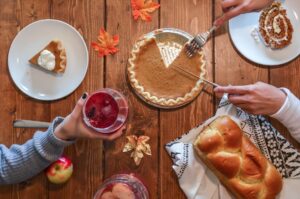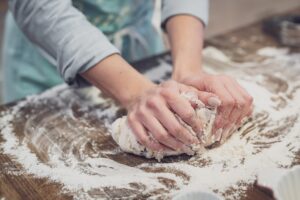
How to Avoid Food Poisoning at Your Holiday Feast
Ensuring a safe and enjoyable holiday feast means taking the necessary precautions to avoid food poisoning. The holiday season is a time for celebration, and the last thing you want is for your festive gathering to be marred by illness! So, let’s explore essential tips and practices to help you safeguard your holiday meal, ensuring that your loved ones leave with cherished memories rather than upset stomachs.
Know your ingredients
If you want to avoid the guilt of causing an accident, you must approach shopping carefully. Knowing your ingredients is the first step in ensuring a safe and enjoyable holiday feast! Start by selecting fresh ingredients, inspecting expiration dates, and handling perishables properly. Freshness is key to a successful meal, so choose fruits, vegetables, and meats that look vibrant and are free from signs of spoilage.
Always check expiration dates on packaged items and avoid buying anything past its prime. Also, when handling perishables like meat and dairy products, ensure they are kept at the right temperature to prevent bacterial growth.
Avoid food poisoning at your holiday feast: Cleanliness is key
Cleanliness is the linchpin for ensuring food safety during your holiday feast preparations. Proper hygiene practices are pretty much a guarantee for trouble. So, begin with thorough handwashing, which should always be your first step before handling any ingredients. Clean kitchen surfaces, cutting boards, and utensils diligently to prevent cross-contamination. That means using hot, soapy water and sanitizing solutions where necessary.
Avoid the common pitfall of using the same cutting board for raw meat and vegetables without proper cleaning in between as well. In addition, towels and sponges can harbor harmful bacteria, so replace them frequently or use disposable options.
Thawing safely
Thawing safely is vital to avoiding food poisoning at your holiday feast. It’s essential to avoid methods like leaving food out at room temperature, as this promotes bacterial growth. Instead, opt for safe techniques such as thawing in the refrigerator.
Planning ahead is key here because thawing this way takes time, especially for larger items like turkeys. For a quicker option, use cold water thawing in a sealed plastic bag, ensuring the water remains cold, and changing it every 30 minutes. The microwave can also be used, but cooking the food immediately afterward is important to avoid the danger zone where bacteria thrive.
Proper cooking temperatures
Proper cooking temperatures are the cornerstone of food safety during holiday preparations. Using a food thermometer is non-negotiable, as it’s the only way to ensure your dishes are cooked to the right internal temperature, eliminating harmful bacteria.
Different foods have specific temperature guidelines, so familiarize yourself with these to avoid undercooking or overcooking. For poultry and meat, the magic number is 165°F (73.9°C).
On the other hand, ground meats and egg dishes need to hit 160°F (71.1°C). Proper cooking guarantees safety and preserves flavor and texture, ensuring a memorable holiday meal for your loved ones. So, invest in a reliable food thermometer, and let it be your culinary sidekick for a safe and delicious celebration.
Safe handling of leftovers
Handling leftovers can help prevent foodborne illnesses after your holiday feast. After the meal, promptly refrigerate any remaining food to keep it out of the “danger zone” (between 40°F and 140°F or 4°C and 60°C), where bacteria multiply rapidly. Use airtight containers to seal in freshness and prevent contamination!
When it’s time to reheat, ensure leftovers reach an internal temperature of 165°F (73.9°C) to kill any lingering bacteria. But what if you’re running out of fridge space? In such cases, consider the knowledgeable advice from Zippy Shell Moving and Storage NV and their vast experience in good storage practices. They recommend relying on a climate-controlled room rather than just a pantry to store your leftovers. That helps maintain the right temperature and ensures the safety of your leftover dishes.

Buffet and potluck considerations
Regarding buffet and potluck considerations during your holiday gatherings, ensuring food safety is necessary. Buffets often leave dishes at room temperature for extended periods, creating an ideal breeding ground for harmful bacteria.
To counter this, employ temperature control measures like chafing dishes, warming trays, or crockpots to keep hot foods hot (above 140°F or 60°C) and cold foods cold (below 40°F or 4°C). Additionally, avoid cross-contamination by providing separate serving utensils for each dish and encourage guests not to double-dip.
Be mindful of allergens
Being mindful of allergens is vital to hosting a safe and inclusive holiday feast. Start by inquiring about dietary restrictions and allergies from your guests ahead of time. This thoughtful gesture lets you plan a menu accommodating everyone’s needs.
When preparing dishes, clearly label those containing common allergens like nuts, dairy, or gluten. Take precautions to prevent cross-contact by using separate utensils and cookware for allergen-free dishes. And, if possible, prepare allergen-free alternatives so all your guests can enjoy the festivities without worry.
Safe handling of seafood
Safe handling of seafood is essential during holiday feasts. Always start by ensuring the freshness of your seafood. It should have a mild, ocean-like scent, not a strong fishy odor. Then, store seafood properly at cold temperatures and use it promptly to avoid spoilage.
When preparing seafood, cook it to the recommended internal temperature of 145°F (62.8°C). Overcooking can produce a rubbery texture, so use a food thermometer to get it right. Lastly, seafood can be a common source of foodborne illnesses, so if you start suffering from any kind of pain or discomfort, quickly follow up on that with a doctor. Taking chances with seafood is not smart, even if you take all the necessary steps to avoid food poisoning.

Ensuring safe baking practices
Ensuring safe baking practices can aid in avoiding food poisoning. To protect yourself from accidents, begin by checking for any recalled baking ingredients or equipment. Properly store and handle ingredients like flour, which can carry harmful bacteria.
When working with flour or raw dough, avoid the temptation to taste it, as raw flour can harbor pathogens. Always bake dough and batter to the recommended temperature, ensuring it is fully cooked! Use oven mitts or pot holders to handle hot bakeware, and be cautious when opening the oven to prevent burns.

For a truly happy and tasty holiday feast
As you tackle your holiday feast, with the knowledge and practices to avoid food poisoning, you can protect yourself and your loved ones. So, keep these tips in mind, and may your future holiday gatherings be filled with laughter, gratitude, and the warmth of shared meals, free from the worry of foodborne mishaps!
